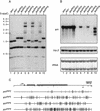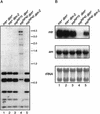DNA methylation inhibits elongation but not initiation of transcription in Neurospora crassa
- PMID: 9308966
- PMCID: PMC316521
- DOI: 10.1101/gad.11.18.2383
DNA methylation inhibits elongation but not initiation of transcription in Neurospora crassa
Abstract
In plants, animals, and fungi, DNA methylation is frequently associated with gene silencing, yet little is known about the role of the methylation in silencing. In Neurospora crassa, repeated sequences are silenced by repeat-induced point mutation (RIP) and genes that have suffered numerous GC --> AT mutations by RIP are typically methylated at remaining cytosines. We investigated possible effects on transcription from methylation associated with RIP by taking advantage of 5-azacytidine, which prevents most methylation in Neurospora and a dim-2 mutation that abolishes all detectable methylation. Northern analyses revealed that methylation prevents the accumulation of transcripts from genes mutated by RIP. Measurements of transcription rates in vivo showed that methylation inhibits transcription severely but does not influence mRNA stability. Results of nuclear run-on experiments demonstrated that transcription initiation was not significantly inhibited by the dense methylation in the promoter sequences. In contrast, methylation blocked transcription elongation in vivo.
Figures







Similar articles
-
Cytosine methylation associated with repeat-induced point mutation causes epigenetic gene silencing in Neurospora crassa.Genetics. 1997 Jun;146(2):509-23. doi: 10.1093/genetics/146.2.509. Genetics. 1997. PMID: 9178002 Free PMC article.
-
DNA methylation associated with repeat-induced point mutation in Neurospora crassa.Mol Cell Biol. 1995 Oct;15(10):5586-97. doi: 10.1128/MCB.15.10.5586. Mol Cell Biol. 1995. PMID: 7565710 Free PMC article.
-
The methylated component of the Neurospora crassa genome.Nature. 2003 Apr 24;422(6934):893-7. doi: 10.1038/nature01564. Nature. 2003. PMID: 12712205
-
RIP: the evolutionary cost of genome defense.Trends Genet. 2004 Sep;20(9):417-23. doi: 10.1016/j.tig.2004.07.007. Trends Genet. 2004. PMID: 15313550 Review.
-
Genetic and epigenetic inactivation of repetitive sequences in Neurospora crassa: RIP, DNA methylation, and quelling.Curr Top Microbiol Immunol. 1995;197:165-77. doi: 10.1007/978-3-642-79145-1_11. Curr Top Microbiol Immunol. 1995. PMID: 7493491 Review. No abstract available.
Cited by
-
Selection and Characterization of Mutants Defective in DNA Methylation in Neurospora crassa.Genetics. 2020 Nov;216(3):671-688. doi: 10.1534/genetics.120.303471. Epub 2020 Sep 1. Genetics. 2020. PMID: 32873602 Free PMC article.
-
Collateral damage: spread of repeat-induced point mutation from a duplicated DNA sequence into an adjoining single-copy gene in Neurospora crassa.J Biosci. 2005 Feb;30(1):15-20. doi: 10.1007/BF02705146. J Biosci. 2005. PMID: 15824437
-
DNA methylation and normal chromosome behavior in Neurospora depend on five components of a histone methyltransferase complex, DCDC.PLoS Genet. 2010 Nov 4;6(11):e1001196. doi: 10.1371/journal.pgen.1001196. PLoS Genet. 2010. PMID: 21079689 Free PMC article.
-
Causes and Consequences of Age-Related Changes in DNA Methylation: A Role for ROS?Biology (Basel). 2014 Jun 18;3(2):403-25. doi: 10.3390/biology3020403. Biology (Basel). 2014. PMID: 24945102 Free PMC article.
-
PARP is involved in replicative aging in Neurospora crassa.Fungal Genet Biol. 2010 Apr;47(4):297-309. doi: 10.1016/j.fgb.2009.12.012. Epub 2010 Jan 4. Fungal Genet Biol. 2010. PMID: 20045739 Free PMC article.
References
-
- Bartolomei MS, Webber AL, Brunkow ME, Tilghman SM. Epigenetic mechanisms underlying the imprinting of the mouse H19 gene. Genes & Dev. 1993;7:1663–1673. - PubMed
-
- Bednarik DP, Duckett C, Kim SU, Perez VL, Griffis K, Guenther PC, Folks TM. DNA CpG methylation inhibits binding of NF-kB proteins to the HIV-1 long terminal repeat cognate DNA motifs. New Biol. 1991;3:969–976. - PubMed
-
- Beelman CA, Parker R. Degradation of mRNA in eukaryotes. Cell. 1995;81:179–183. - PubMed
Publication types
MeSH terms
Substances
Grants and funding
LinkOut - more resources
Full Text Sources
Other Literature Sources
Miscellaneous
